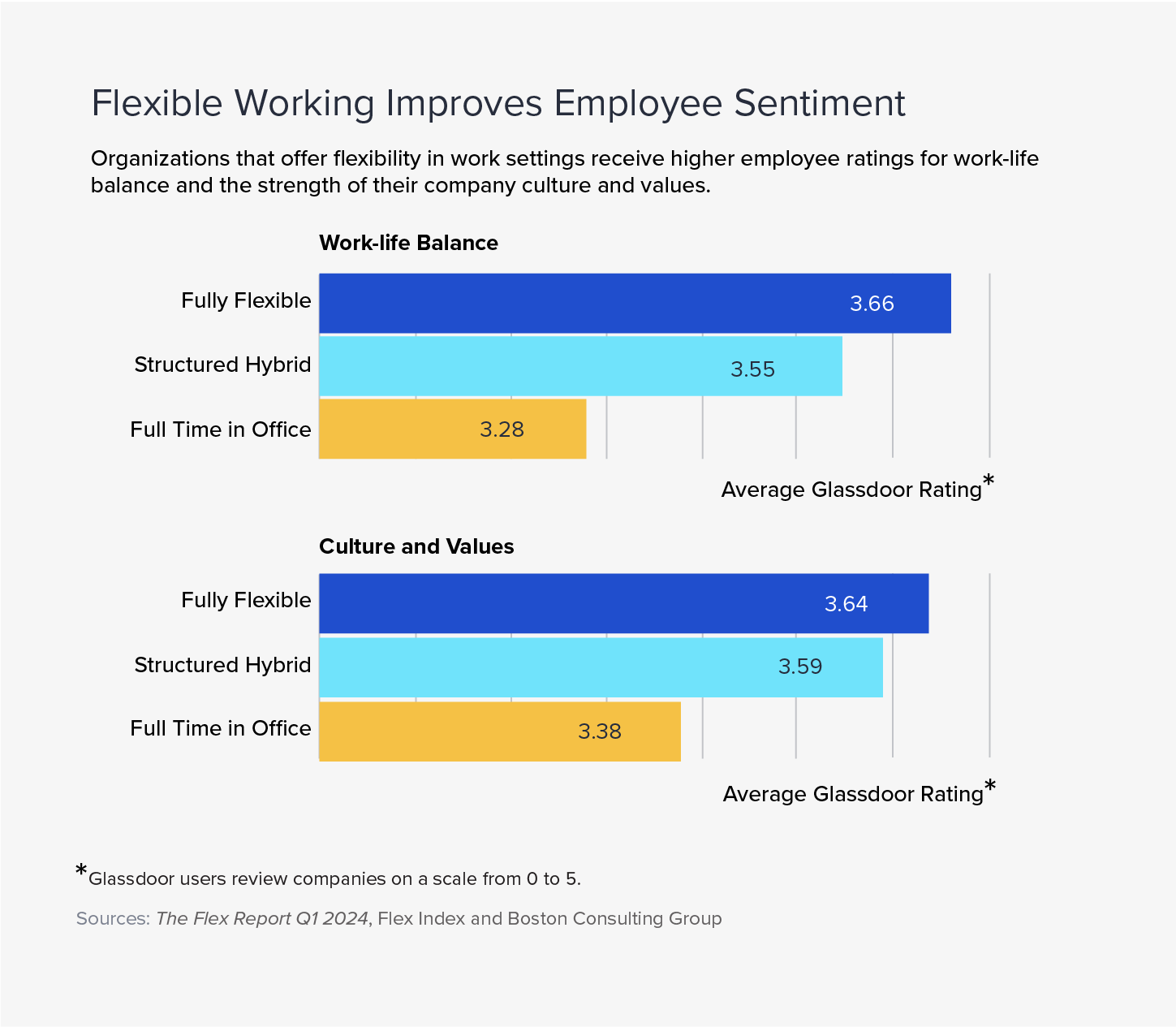Instacart’s Approach to Empowering Employees Through Flexible Work
authors are vetted experts in their fields and write on topics in which they are extremely knowledgeable. All of our content is peer reviewed and validated by world-class professionals.

It’s no secret that organizations across various industries struggle to balance remote work flexibility with maintaining strong team cohesion. The dilemma has even prompted some C-suite leaders to pin their cohesion problems on remote work, forcing employees back to the office full time—and then regretting their decision when engagement plummets and turnover skyrockets. One July 2023 survey by The Conference Board found that 71% of HR executives from organizations that mandate on-site work reported difficulty retaining workers.
At Instacart, we’ve designed a flexible work model focused on fostering collaboration and a commitment to our company’s core values. Flexibility, after all, is at the heart of our business model. Instacart makes it possible for millions of people to get the groceries they need delivered to their door, on their own schedule, from more than 1,500 national, regional, and local retailers. Just as in-person grocery shopping is a struggle for many people in our increasingly busy world, so too is a rigid commitment to in-person work.
When we first contemplated a lasting flexible work model for the company in the wake of the COVID-19 pandemic, we understood that we needed a well-structured approach that would maintain employee engagement and productivity while attracting and retaining the talent at the heart of our growth. In 2022, we introduced our “Flex First” model, which provides our employees the autonomy to live anywhere within the country they’re based while participating in regular in-person gatherings.
We designed Flex First based on three core principles: flexibility, connection, and equity.
Our commitment to those principles is the engine that has powered the program’s success—and ensured our employees remain as engaged as ever. Here’s how our model ensures that success.

A Foundation of Flexibility
Our Flex First model gives our employees the ability to work daily from the location that’s best for them, with no expectation of how much time they will spend in the office. It allows them to balance their personal and professional lives—a balance that is a boon for our company too. I’m a big believer that having a fulfilling life outside of work enriches employee performance, a belief that’s backed up by decades of research.
A three-year analysis of 554 public companies—published in November 2023 by Flex Index and Boston Consulting Group—found that “fully flexible” firms that allow employees to choose when they come to an office increased their sales at a much faster rate than their peers.
Flexibility also helps us retain and attract the best people. Great talent is not limited to a certain ZIP code, and this model allows us to attract talent from everywhere and retain employees as they move around their respective countries. It’s been especially helpful for our employees with spouses or partners who must work in a specific location. We’re providing that release valve so people can live and work anywhere.
On the flip side, we offer space for staff who prefer to work from our offices in San Francisco, Chicago, New York City, and Toronto. These offices are open for employees to come in whenever they choose to work, attend meetings, grab lunch with coworkers, or participate in any team happy hours. Our employees in New York City, who tend to live in smaller spaces, particularly appreciate having this option.
Maintaining Connection and Community
While remote work gives workers the flexibility they need, team cohesion can suffer if companies aren’t intentional about creating opportunities for connection. That begins with providing the tools necessary to keep people in touch virtually. We’re active users of Slack and the Google Suite.
We’re also deliberate about keeping our employees informed on company priorities, exciting launches, and upcoming events. Once a week, our leadership team hosts a virtual meeting, usually in the format of an “Ask Me Anything” session, where staff can ask specific questions. We also created a Slack channel where leaders can post videos regularly about updates to the business. These highlight everything from behind-the-scenes looks at the Cannes Film Festival to a live demo of our AI-powered smart cart, Caper Cart, to suggestions for ways to commemorate holidays like Juneteenth.

While we have built a strong community virtually, we also recognize the benefits of face-to-face interaction and collaboration. We believe that it’s fundamental to our culture to highlight both modalities, which is why we offer meaningful opportunities for teams to reconnect in-person throughout the year.
One of my favorite ways that we build a sense of community is with our “Team Jams,” which are team-bonding experiences at the team, department, or even company level to foster relationships and build a deeper sense of community. Every team has access to travel funds, office space, and tools to host memorable events to attend in-person at least twice a year. While these are optional, we encourage everyone to attend as we see them as important investments in employees’ growth and the success of our teams. As a result, we’ve found that teams look forward to these events.
In May 2024, the Design and Research team attended a fireside chat titled “Building Experiences for Everyone in the Era of AI” with inclusive building advocate Annie Jean-Baptiste before an ice cream and affogato meetup. Separately, the Search and Catalog Experience team recently hosted a brainstorming session on AI before bowling at Lucky Strike. In July, the Connected Store, Caper, and FoodStorm teams hosted a virtual fireside chat with Instacart CEO Fidji Simo before heading off to a San Francisco Giants game in the afternoon.
Additionally, we encourage our employees to choose regular optional in-office days based on team needs. For instance, if there is a timely project, some teams may decide to align on an in-office day to tackle this work, or create an in-office day focused on planning efforts or organic brainstorms. We also provide regular opportunities for teams to gather in-person as schedules allow, including company all-hands meetings, quarterly planning meetings, or our annual vision summit.
To that end, we have transformed our offices to offer dynamic spaces with lounges, areas for cooking classes, auditorium spaces, brainstorming areas with digitally connected whiteboards for remote collaboration, and more. We provide breakfast and lunch at many of our offices and even once-a-week morning mixers so people can come together over coffee, a croissant, or the soup of the day.
Ensuring Equity and Opportunity
At Instacart, we know that diversity, equity, and belonging are essential to our success, and we must approach these policies the same way we do any business goal: intentionally, and with the resources they require. Our Flex First model is central to that effort. One of the biggest benefits of a flexible work model—when done well—is that it boosts diversity by eliminating many of the stressors that push caregivers out of the workforce, and it provides opportunities to applicants from around the world, or ones who might struggle with a daily commute. That’s why remote work has been credited with the growth in labor participation among mothers and people with disabilities.

However, hybrid work models run the risk of offering better access and opportunities to people who come into the office. That’s especially true when senior leaders work from the office, while junior staff work remotely. The benefit of our Flex First model is that it eliminates that proximity bias by putting all employees on a level playing field. Everyone across our company works virtually during most of our meetings. Our employees in San Francisco aren’t in a different situation from those in Denver or Missoula. They all have equal access to the career development opportunities necessary for growth.
What HR Leaders Should Know
Focusing on flexibility, connection, and equity has helped us implement a successful approach to work at Instacart. I would recommend HR leaders keep these values as touchstones when crafting their own model. In addition, I’ve found the following to be crucial:
- Transparency is key. One of our core values at Instacart is “put it all on the table.” We believe in building trust through transparency, so we aim to be transparent in what we share with employees so that they don’t feel in the dark. It’s important to thoroughly communicate critical business across many channels—like emails, meetings, and Slack messages—so employees are informed and can understand the context of why certain updates are beneficial to the company and their own success.
- Don’t neglect the middle. Managers are an important scaffold in the middle that can make or break the success of a flexible work model, so we continue to focus on developing and training them. We encourage regular one-on-one and team meetings, because when managers don’t see someone physically, they have to make a real effort to listen, drive positive interactions, and build connections with their employees. It’s very important to cultivate that skill. We get great feedback from our employees—a recent internal Instacart survey reported 88% satisfaction rates when polled about trust in their managers.
- Think like a business leader. Another one of our values at Instacart is “grow the pie,” which means looking for solutions where everyone wins. HR people are business people too, so whether it’s using tech in the right ways or working cross-functionally to try and solve a problem quickly, HR leaders should think about how they can generously serve their company’s employees and customers.
- Establish trust. I have to be an example of what I’m hoping to see in people, especially regarding our key Instacart values and cultural tenants. I try to make sure that I’m building trust, not only in terms of honoring our commitment to flexibility but also in terms of making sure that if I say I’m going to do something, I do it.
Our Flex First approach is proof that flexible work models that prioritize connection and equity can help employees manage their responsibilities at home while growing their career. It keeps employees engaged and productive while attracting and retaining talent—an advantage in today’s labor market. Survey after survey shows that workers deeply value flexible work. In an era of tighter budgets, thoughtfully designed flexible work policies are an affordable way for companies to win the war for talent and nurture a culture where their employees thrive—at home and work. At Instacart, it’s a win-win that truly enables us to grow the pie for our employees and customers.
